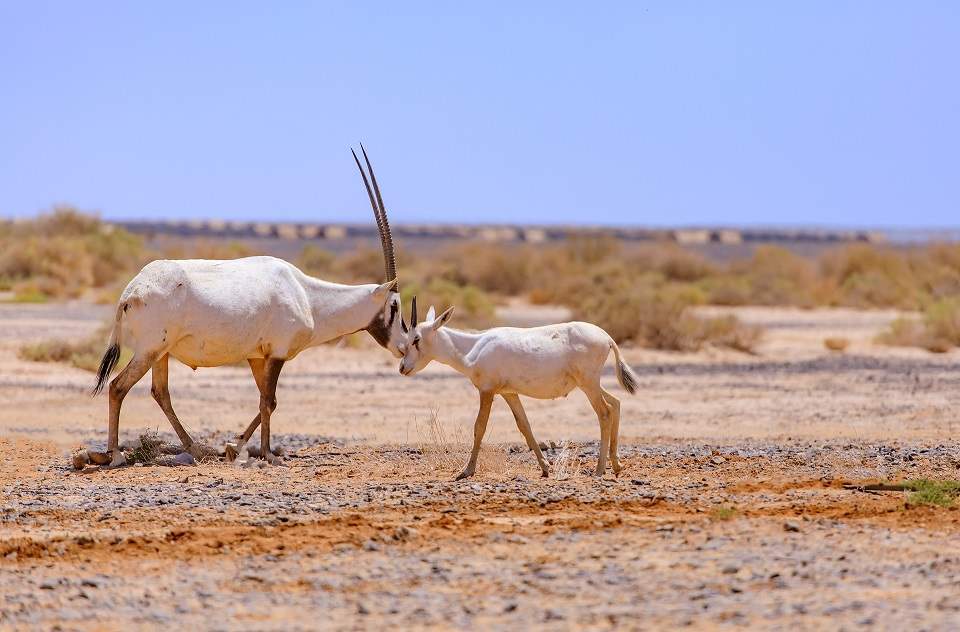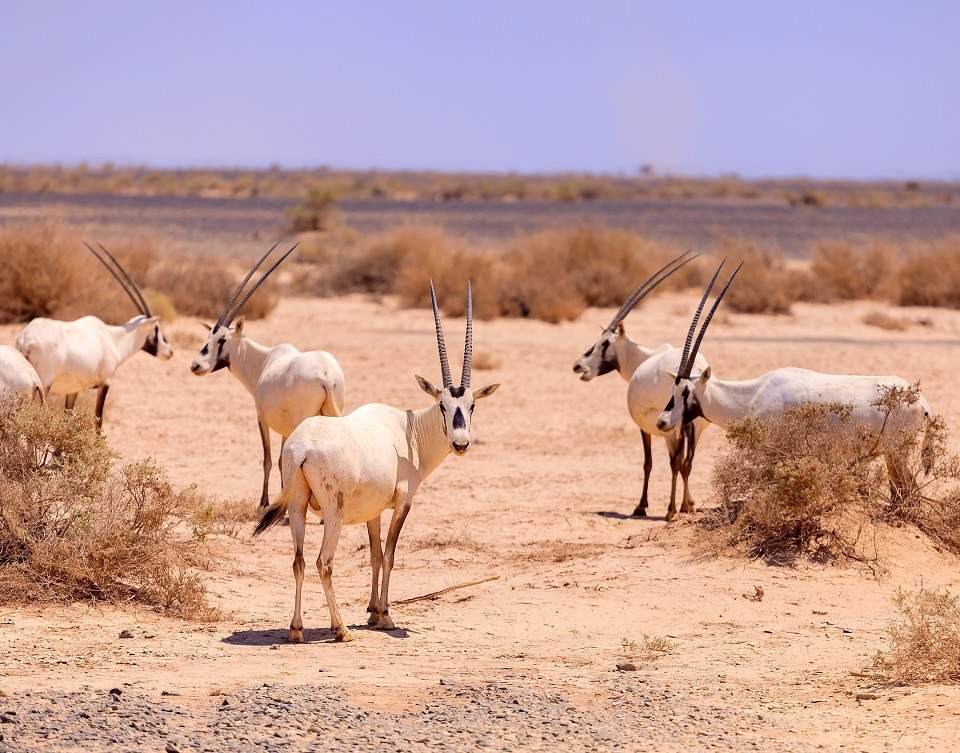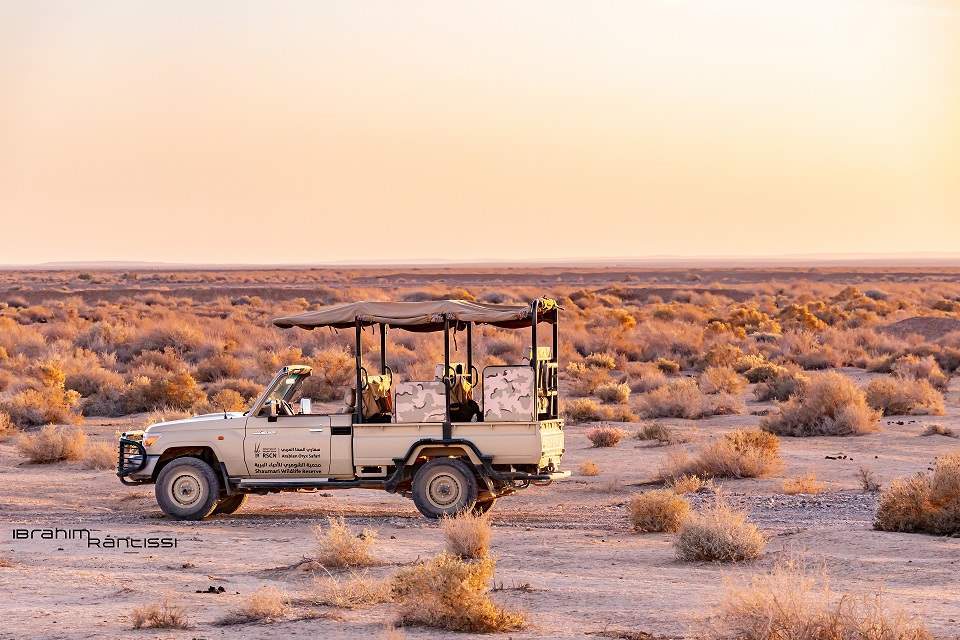AMMAN — Loping across the dusty, scrubby landscape, the
white Arabian oryx is distinct against the brown-gold glow of the evening sun.
A mother rubs her head against her calf, her elegant horns stretching half a
meter taller than his new, stubby horns; another oryx slowly munches on a
scrubby bush.
اضافة اعلان
 A collection of photos taken at the Shaumari Wildlife
Reserve near Azraq, in Jordan. The park hosts a conservation success story in
the Arabian oryx, which was once completely wiped out in Jordan. (Photos:
Ibrahim Rantissi/Jordan News)
A collection of photos taken at the Shaumari Wildlife
Reserve near Azraq, in Jordan. The park hosts a conservation success story in
the Arabian oryx, which was once completely wiped out in Jordan. (Photos:
Ibrahim Rantissi/Jordan News)
Not far away, a fourth oryx appears and disappears amongst the
bushes, its black and white face markings merging with the dappled evening
shadows.
Shaumari Reserve is a peaceful haven for these creatures, which were once
wiped out in Jordan.
The
Arabian oryx, a wild, white antelope that is the
national animal of Jordan, became extinct in the Kingdom around 100 years ago.
Some 50 years later, in 1972, the very last wild Arabian oryx was killed by
hunters in Oman.
Increased hunting and human expansion ultimately led to the
decline of the distinctive antelope, which had previously ranged across much of
Jordan and neighboring countries.
However, decades of dedicated conservation programs have
worked to bring the Arabian oryx back to its natural habitat, and herds have
since been transplanted to Jordan, Saudi Arabia, Oman, the United Arab Emirates,
and Syria.
 A collection of photos taken at the Shaumari Wildlife
Reserve near Azraq, in Jordan. The park hosts a conservation success story in
the Arabian oryx, which was once completely wiped out in Jordan. (Photos:
Ibrahim Rantissi/Jordan News)
A collection of photos taken at the Shaumari Wildlife
Reserve near Azraq, in Jordan. The park hosts a conservation success story in
the Arabian oryx, which was once completely wiped out in Jordan. (Photos:
Ibrahim Rantissi/Jordan News)
Today, visitors can find a herd of up to 95 oryx at the Shaumari Wildlife
Reserve, a 22sq.km protected area in the east of Jordan, near Azraq.
Shaumari, which is managed by the Royal Society for the
Conservation of Nature (RSCN), was the first wildlife reserve to be established
in Jordan in 1975, and it has since provided a protected environment for
extinct and endangered animals to thrive and breed in their natural habitat.
The site manager for the reserve, Ashraf Elhalah, explains
that the RSCN has been working hard in recent years to improve the genetic
diversity of the oryx herd: “We noticed in the last year that the herd has a
few problems in the population, such as the abnormality in the horn or early
mortality,” he told
Jordan News in an interview.
Elhalah added that because of this, the RSCN began
collaborating with neighboring countries in order to diversify the oryx
population.
He said: “We import Arabian oryx and gazelle from Saudi Arabia …
also with the same purpose to improve genetic diversity of the Arabian oryx,
and now we are working with the environmental agency in the United Arab
Emirates, also to continue improving the genetic diversity.”
These efforts have seen the site nearly reach its maximum
capacity for Arabian oryx in recent years, a far cry from the mammal’s dire
situation less than a century ago.
Shaumari Reserve is also home to ostriches, gazelles, onagers
(a wild Asian donkey), wild rabbits, a variety of venomous and non-venomous
snakes, and migrating birds such as raptors.
 A collection of photos taken at the Shaumari Wildlife
Reserve near Azraq, in Jordan. The park hosts a conservation success story in
the Arabian oryx, which was once completely wiped out in Jordan. (Photos:
Ibrahim Rantissi/Jordan News)
A collection of photos taken at the Shaumari Wildlife
Reserve near Azraq, in Jordan. The park hosts a conservation success story in
the Arabian oryx, which was once completely wiped out in Jordan. (Photos:
Ibrahim Rantissi/Jordan News)
Hassan Shishani, a tour guide at the reserve, told
Jordan
News that “The most important thing that is eye catching for me (at the
reserve) is the migration of birds.
The migration of birds starts in spring and
ends in summer, and the second season starts in autumn. They go from Europe to
Africa in autumn looking for moderate temperatures and food.”
While Shaumari Reserve has a special glow under the evening
sun, Shishani explains that the best time to visit is in the morning, at around
9am, as this is “the best time to see animals that are more active.” He also
explains that spring, particularly in March and April, are some of the best times
for seeing the reserve’s animal populations.
Shaumari Reserve has a visitor’s center where guests can see
a selection of the animals up close behind glass, but Shishani recommends
taking a safari tour in order to see the wildlife in its natural habitat.
There
are two tours visitors can take, one which covers 7km and takes around an hour,
and a longer tour which covers 14km and lasts for up to two and a half hours,
with a break for tea infused with medicinal herbs, brewed on a campfire.
While visitors get a brief insight into the reserve on
safari and visitors center trips, site manager Elhalah explains that there are long
term challenges facing the reserve.
Among these challenges, Elhalah explained
that both the pandemic and land use beyond the reserve have severely affected
operations at Shaumari.
“Coronavirus made a very big change in the tourism activity
here in Jordan and also outside.
We completely shut down our tourism program in
2020, and now we start to work again, but tourism is still minor,” he said.
Elhalah added that water scarcity and water collection
methods in the surrounding areas also present an ongoing issue: “Many of the
impacts on the water resources and also on the vegetation cover outside of the
protected area reflect negatively on the protected area itself,” he said.
“We
have to think now about changing our plan and making improvements for water
distribution inside the reserve and also thinking about making water collection
… in order to regenerate new vegetation cover for wild species inside.”
Indifferent to the potential threats to their survival, the
Arabian oryx lope on through the scrubland of the Shaumari Reserve.
A single oryx
bows its head to graze on a bush before continuing on its journey. Having returned
from extinction to thrive in its new-old habitat, the resilient animal appears
unfazed by the dangers the next century might bring.
Read more
Around Jordan



